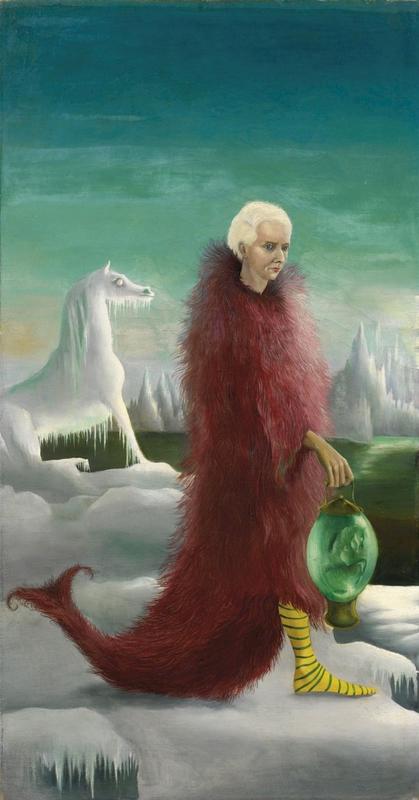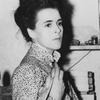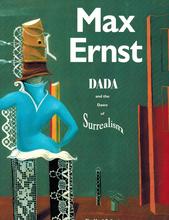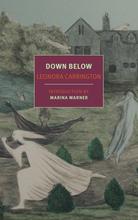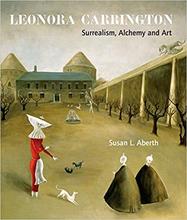More about Portrait of Max Ernst
- All
- Info
- Shop
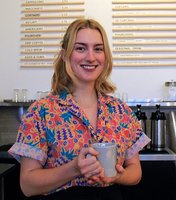
Contributor
Leonora Carrington, surrealist author, painter, and horse girl, painted this dreamily odd portrait of her much older boo, Max Ernst, in 1939.
Twenty-two year old Carrington painted this portrait when the two lived together in the French countryside, right before Max Ernst would be interred by the French government for, basically, being German. A short, but intensely creative and tumultuous relationship, Ernst and Carrington made many portraits of each other and pushed each other artistically.
While Leonora Carrington does not get her true due as a surrealist (classic), she was incredibly talented, very headstrong, and maybe a little psychic? In the year before Carrington and Ernst would meet in Paris, she was struck by a rendering of his painting Two Children Threatened by a Nightingale when her mom gave her a book on Surrealism. They fell hard, like love at first sight hard. Carrington was completely enamored, and believed him to be "the man that every woman waits for," although her opinion would develop and change with age.
What’s really important to know about Carrington, is that she was a next level horse-girl. She puts Taylor Swift to shame, truly, with an obsession so intense she was reportedly shocked as a child when her mom had to tell her (again) that she was in fact NOT a horse. Early on, Leonora used the horse as a proxy for herself in her stories, paintings, and drawings. Other surrealists also used animals as surrogates for themselves, and even Ernst had his own emblem, “Loplop the bird superior”.
We see both avatars in this painting, with two horses including a giant icy one, seated like a dog, springing from the ice in the background, and the small one in the lantern that Ernst is holding. Ernst is also in a fabulous feathery mermaid coat, both a reference to his alter ego Loplop and a mermaid sculpture at the home they shared in France. Most reports of their relationship show that in 1939 the couple was still happy, perhaps best evidenced in the desperate letters she sent to her friends when Max was interned at a camp for German citizens.
And yet, different scholars read the painting in very different ways. Some believe the horse in the lantern represents Leonora leading Max into a future together with the ice horse watching on, while others believe this painting represents a turn in their relationship. The latter think this frozen white horse is Leonora, unable to live freely as depicted by the running white horse in her self portrait. By that reasoning, lantern horse is ALSO her, trapped by Ernst and objectified into something useful for him. Honestly, this is one horsey girl, so I could see it either way, one horse Leonora or two.
Interestingly, Leonora only said one thing about this painting in an interview much later in life; “At that time I still accepted a lot of s***. Being a muse, all it means is that you’re somebody’s object, I was totally in love with [Ernst] fascinated by him, but I was so young." While Leonora was a rebel- leaving her boring rich English parents to live in Paris and become an artist, she eventually recognized that while Ernst had helped her focus her artistic energy, he was still sad boy artist and had room for improvement.
After their separation due to World War II, they emigrated separately to America and married other people for convenience. Ernst was really trying to get back on the Leonora train, but perhaps by then, after being tortured in a mental institute in Spain she had outgrown objectification by silver haired foxes. Carrington went on, continuing to be fabulous, and eventually broke the record for the highest price paid for a painting by a living Surrealist. More depressing than the early demise of their relationship, Carrington eventually moved away from using horses as her avatar. But I firmly believe, once a horse girl, always a horse girl.
Sources
- Allmer, Patricia. Intersections : Women Artists/surrealism/modernism. Rethinking Art's Histories. Manchester: Manchester University Press, 2016.
- Chadwick, Whitney; Ades, Dawn. Mirror Images : Women, Surrealism, and Self-representation. Cambridge, Mass.: MIT Press, 1998.
- Colvile, Georgiana. 1991. "Beauty and/Is the Beast: Animal Symbology in the Work of Leonora Carrington, Remedios Varo and Leonor Fini." In Surrealism and Women, edited by Mary Ann Caws, Rudolf Kuenzli and Gwen Raaberg, 159. Cambridge, Mass: MIT Press.
- Elliot, Patrick. “Leonora Carrington’s Portrait of Max Ernst” Lecture by Chief Curator, Scottish National Gallery of Modern Art, Edinburgh, Scotland, 11 September 2018.
- Hooks, Margaret. Surreal Lovers : Eight Women Integral to the Life of Max Ernst. Madrid, Spain: La Fábrica, 2017.
- Hubert, Renée Riese. Magnifying Mirrors : Women, Surrealism, & Partnership. Lincoln: University of Nebraska Press, 1994.
- Levitt, Annette S. The Genres and Genders of Surrealism. 1st ed. New York: St. Martin's Press, 1999.
- National Galleries of Scotland. "Portrait of Max Ernst.", last modified September 13, accessed January 25, 2019, https://www.nationalgalleries.org/art-and-artists/164061/portrait-max-e….
- Rosemont, Penelope. Surrealist Women : An International Anthology. 1st ed. Surrealist Revolution Series. Austin: University of Texas Press, 1998.
Featured Content
Here is what Wikipedia says about Portrait of Max Ernst
Portrait of Max Ernst, also known as Bird Superior – Portrait of Max Ernst, is an oil on canvas painting by English artist Leonora Carrington, created c. 1939. The painting was made when the two artists were having a short-lived affair. It is held at the Scottish National Gallery of Modern Art, in Edinburgh, who purchased it in 2018. It was the first work by the artist acquired by the museum.
Check out the full Wikipedia article about Portrait of Max Ernst

